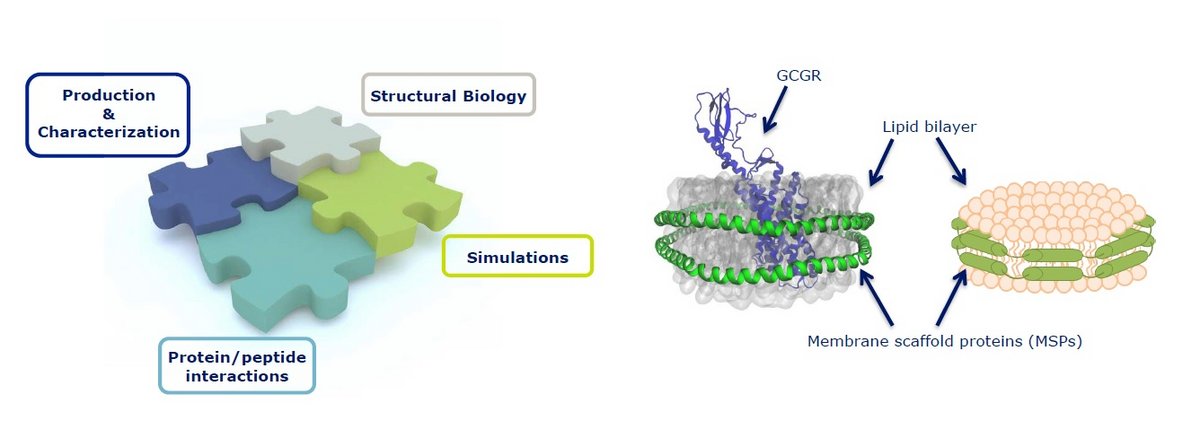Danes suffering from diabetes and haemophilia, for example, can look forward to more treatment options in the future. Today, it is both time-consuming and expensive to develop new drugs, but it can be done more intelligently and more quickly. This is what industrial PhD Lisbeth Ravnkilde Kjølbye thinks, and with Novo Nordisk and the Department of Chemistry, she is working to find a tool to make the development process faster and cheaper.
One needle to measure blood sugar, and another to inject insulin to stabilise the blood sugar.
That is the traditional treatment for diabetics. Up to now. Novo Nordisk has a dream to develop a different treatment, but the process can take a very long time. Industrial PhD Lisbeth Ravnkilde Kjølbye from Aarhus University is striving to do something about this, and her goal is to find a tool to push Novo Nordisk's dream a little in the right direction.
- It’s important work because it may have a huge influence on drug development in the future, says Jesper Ferkinghoff-Borg, who is a PhD supervisor and researcher at Novo Nordisk A/S.
Traditionally, many tools can be used to develop drugs. For example, researchers can examine the body's reaction to a specific drug in a laboratory by examining cells to see how the drug affects the receptors that are affected by the membrane, but the results are not very detailed, explains Jesper Ferkinghoff-Borg.
- It’s generally very difficult to get a detailed understanding of how the receptors react. In some contexts, we try to make very large experiments in which we scan everything possible and try to find patterns and tendencies. This is not particularly rational because we don't know much about the reactions, he says.
Lisbeth Ravnkilde Kjølbye is aiming at developing a tool to give more detailed results and thus also a more rational approach to new drugs.
In the industrial PhD, the parties are trying to develop a computer simulation of what happens in the body when a new molecule from a drug reaches the receptors in the cells. In the long term, this will become a computer-based protocol that shortens the process of developing new drugs without sacrificing quality.
- A protocol will save Novo Nordisk a lot of time and money in their work because they won’t need to test all the tools in the catalogue. There is an enormous number of tools we can use in work on cellular receptors, explains Lisbeth Ravnkilde Kjølbye.
Not only will Novo Nordisk A/S save money and time, they will also get much more information out of the experiments by means of the protocol, stresses Jesper Ferkinghoff-Borg.
- The trick is to do the experiments using a computer. This gives us a lot more information, because we can follow everything that’s happening in the body. In traditional experiments, some of the information we get may be affected by other changes in the body, for example as a result of diet, age and disease, he explains.

Lisbeth Ravnkilde Kjølbye has dedicated three years of her degree programme to developing a computer-based protocol from which Novo Nordisk can predict the reactions of cellular receptors to different drugs. She does this by means of nano-discs, which are small models of a cell membrane. They are compared with cell membranes to find out about the molecular communication between the molecules in the membrane and the embedded receptors.
The nano-discs can be tested in the laboratory, but this is time-consuming and costs a lot of money. Instead, Lisbeth Ravnkilde Kjølbye’s work takes place in front of two computer screens at the Department of Chemistry in Aarhus and at Novo Nordisk in Måløv, respectively.
- The nano-discs are a very stable tool. But there are also a great many parameters to set for them in relation to changing cells, she says.
In the long term, Novo Nordisk hopes to be able to use Lisbeth Ravnkilde Kjølbye’s results to shorten the development process for a new diabetes treatment, for example. This may be a pill to replace blood glucose measurements and insulin injections, suggests the industrial PhD, and even though her research is only a small corner of a huge knowledge area, she is happy to be part of the development.
- It’s very exciting to be involved at both theoretical and practical levels. I’m adding value to Novo Nordisk and I also have to be able to document my results in scientific articles. You have to keep your wits about you, because it's not easy - but it's exciting, she says, smiling.
Lisbeth Ravnkilde Kjølbye’s project runs from 1 February 2018 to 1 February 2021.